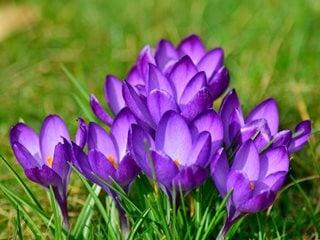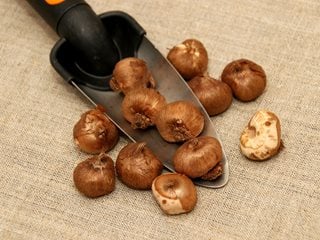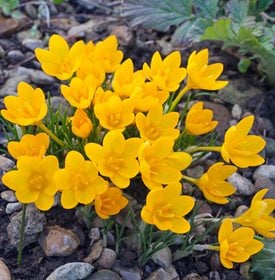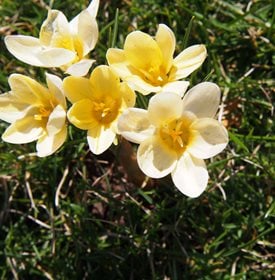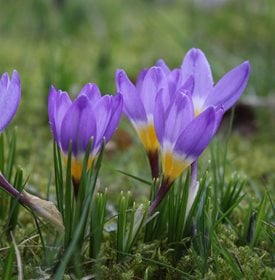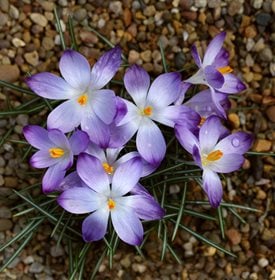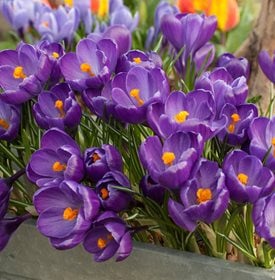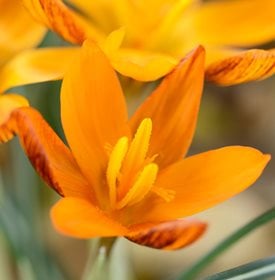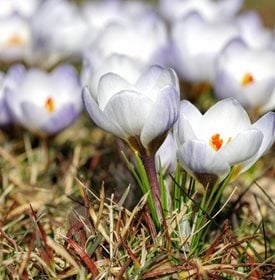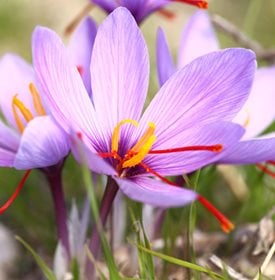GROWING COLORFUL CROCUS FLOWERS
Growing and care tips for this early blooming spring flowerCrocus flowers lead the way for other spring bloomers to follow. They bloom bright and early, bringing much needed color after a long winter. These small-but-mighty plants with their colorful blooms and sweet fragrance lure hungry bees out of their hives. Crocus plants will multiply and come back year after year, bringing more blooms with them each time.
On this page: The Basics | Planting | Crocus Care | Pictures | Design Tips | Forcing Indoors
CROCUS BASICS
Zones:
3-8; they will typically not grow in hotter climates.
Height/Spread:
3 to 6 inches tall & wide
Exposure:
Partial to full sun
When do crocus bloom?
Most bloom late winter to early spring, depending on the variety; however, there are types that bloom in the fall. Several blossoms will be produced by each corm.
Color and characteristics:
Crocus flowers bloom in a variety of bright colors including purple, lavender, blue, orange, yellow, cream and white. They have narrow, grass-like foliage.
Types:
There are 2 types of spring-flowering crocuses: Species varieties, (snow crocus or wild crocus), that are smaller and the first to bloom; and the more common Dutch crocus (hybrids of Crocus vernus) that have larger flowers and bloom a little later than the species varieties. Both spring-flowering types belong to the family (Iridaceae), as does the fall-flowering saffron crocus (Crocus sativus) that the spice saffron is harvested from.
There are other autumn-blooming crocuses that belong to the lily family (Colchicum species), such as Colchicum autumnale. Plant these in late summer and they will bloom with flowers in fall and send up secondary foliage in spring. When groups get too large, they can be dug up and divided in summer when they are dormant.
PLANTING CROCUS
When to plant crocus:
Get your spring-blooming crocuses in the ground after the weather cools down in the fall, but before the ground freezes. Generally speaking, this will be September to October in northern zones, and October to November in southern zones.
Where to plant:
Crocus corms can be planted just about anywhere as long as they get full to partial sun and well-drained soil. They’re good to go under deciduous trees, where they’ll get enough sunlight before most trees have fully leafed out. Don’t plant in dense shade, such as on the north side of structures.
How to plant:
Place corms 3 to 4 inches deep, about 3 inches apart and with their pointy ends up. Arrange them in small groups of 9 to 10 per square foot, or in large drifts. Cover with soil level to the surface so water won’t puddle. If you find you need to deter pests like mice or voles from eating your newly planted corms, crushed seashells, oyster shells or eggshells can be added to the planting holes. Water the area well after planting.
For more information on planting bulbs, corms, or tubers, see Planting and Storing Bulbs
CROCUS CARE
Pruning:
Crocuses don’t require any pruning, simply let the foliage die back after blooming and then remove it. It’s important to let it die back naturally, as it is storing food and energy for next season.
Soil:
Although they’re not particularly fussy, they do require well-drained soil so the corms don’t rot. Gritty to sandy soils or rock gardens work well.
Amendments & Fertilizer:
Add a layer of mulch over winter in the coldest zones and remove it in early spring.
Watering:
Established corms need ample moisture in fall when roots are growing and in spring when blooming. Unless rainfall is adequate, water in the amount of ½ to 1 inch of rain per week. Don't water in summer or when plants are dormant or they may rot. You may want to avoid planting them in areas where they will receive water year-round unless you plan on digging them up and storing them.
Propagation:
Crocuses sprout from corms, although the term crocus bulbs is often used as well. Crocuses will naturalize in an area and multiply. Overcrowding may occur after a few years and can cause decreased flowering. Crocuses can be dug up shortly after flowering and divided into smaller clusters to be replanted elsewhere or shared with friends. Corm clusters should be replanted at least 6 inches apart, a little farther than single corms.
Diseases and Pests:
Crocus plants aren’t particularly susceptible to any insect or disease problems. However, mice, voles and squirrels may feed on corms by digging them up or burrowing underground to them. If this is a problem, you can try protecting them with a scent deterrent, screening over the area, or by placing crushed seashells or eggshells into the planting holes. Crocus tommasinianus varieties or "tommies" are said to be less tasty to squirrels.
PICTURES
DESIGN TIPS
- Crocuses are small individually, so grow them in groups or drifts for a spectacular early spring display.
- Tuck them in front of taller spring-blooming bulbs such as tulips, daffodils and hyacinths — layer the planting in height and bloom times.
- Perfect for perennial gardens, mixed borders, and rock gardens.
- Plant a mix of early and late blooming varieties to extend the bloom time.
- Plant en masse in lawns, but be careful because they will multiply and you’ll need to wait to mow until the foliage dies back — usually about 5 to 7 weeks after blooming.
FORCING CROCUS FLOWERS INDOORS
Crocuses can be forced to bloom indoors over winter. Pot them in mid-October in a shallow pan or pot, only about an inch deep and water well. Chill at 38 to 45°F in a dark location for 8 to 10 weeks. Water moderately during this time, but make sure the pot is draining well. Bring them to their desired location at room temperature and they’ll bloom in about 4 weeks. Plants that are forced, cannot be regrown or transplanted outside. Read more on forcing indoor bulbs.
RELATED:
Top 20 Spring-Blooming Bulbs
16 Winter Flowers for Your Garden
Daffodils
Tulips
Hyacinth Flowers
